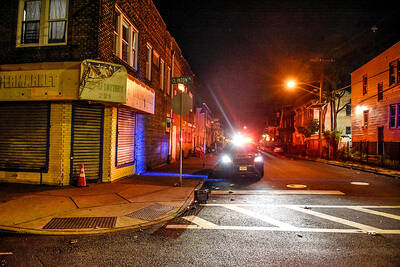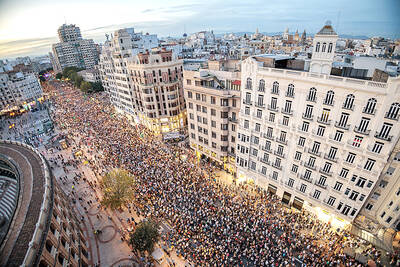A small plane headed for the Everest region crashed in bad weather near the Nepalese capital yesterday, killing all 14 people on board including four Americans, a Japanese and a British national.
The Agni Air plane was returning to Kathmandu after it was unable to land at Lukla, its intended destination in a popular trekking spot in eastern Nepal, government officials said.
Rescuers at the crash site described the scene as “horrific,” with the badly burned remains of the victims strewn over a field around 25km south of Kathmandu.
“Our teams have now reached the site and I can confirm that there are no survivors. All 14 people are dead,” said Bimlesh Lal Karna, head of rescue operations with the civil aviation authority.
“The scene is quite horrific. We are having to battle against hostile terrain and bad weather to recover the remains of the victims. We will bring them back to Kathmandu as soon as the weather permits,” he said.
Local villagers said they saw the plane crash into the field next to a school and break up on impact. The cause of the crash was not immediately clear.
“There are small pieces of the plane all over the field and you can see body parts. We are all so shocked,” villager Pratap Lama told the Kantipur radio station.
Relatives of some of the passengers gathered at the airport in Kathmandu to wait for news.
“My cousin is a trekking guide and he was flying up to take a group of tourists to Everest base camp,” said Ganesh Rijal, 40. “He got married recently and his wife is in deep shock. I have been waiting here for hours, but nobody has been able to tell me anything.”
August is the rainy season in Nepal and helicopters were initially unable to fly to the crash area because of poor visibility. Landslides — a frequent occurrence in Nepal during the monsoon — also hampered road access.
Thousands of travelers fly into Lukla, 140km northeast of Kathmandu, every year to access the stunning Himalayan range that forms Nepal’s northern border with Chinese-controlled Tibet.
The 550m-long sloping airstrip at Lukla, perched on a hillside 2,757m above sea level, is considered one of the most difficult landings in the world and there have been several major accidents there.
The last was in 2008 when a Twin Otter plane carrying 18 people crashed killing everyone on board.
The airport is used by climbers heading for the heights of Everest, though August is the low season for both mountaineering and trekking.
Tourism is a major foreign currency earner for Nepal and the number of visitors has increased since a civil war between Maoist guerrillas and the state ended in 2006.
Earlier this year, the government announced an ambitious plan to attract 1 million tourists to the country next year — around twice the number that visited Nepal last year.

DOUBLE-MURDER CASE: The officer told the dispatcher he would check the locations of the callers, but instead headed to a pizzeria, remaining there for about an hour A New Jersey officer has been charged with misconduct after prosecutors said he did not quickly respond to and properly investigate reports of a shooting that turned out to be a double murder, instead allegedly stopping at an ATM and pizzeria. Franklin Township Police Sergeant Kevin Bollaro was the on-duty officer on the evening of Aug. 1, when police received 911 calls reporting gunshots and screaming in Pittstown, about 96km from Manhattan in central New Jersey, Hunterdon County Prosecutor Renee Robeson’s office said. However, rather than responding immediately, prosecutors said GPS data and surveillance video showed Bollaro drove about 3km

Tens of thousands of people on Saturday took to the streets of Spain’s eastern city of Valencia to mark the first anniversary of floods that killed 229 people and to denounce the handling of the disaster. Demonstrators, many carrying photos of the victims, called on regional government head Carlos Mazon to resign over what they said was the slow response to one of Europe’s deadliest natural disasters in decades. “People are still really angry,” said Rosa Cerros, a 42-year-old government worker who took part with her husband and two young daughters. “Why weren’t people evacuated? Its incomprehensible,” she said. Mazon’s

‘MOTHER’ OF THAILAND: In her glamorous heyday in the 1960s, former Thai queen Sirikit mingled with US presidents and superstars such as Elvis Presley The year-long funeral ceremony of former Thai queen Sirikit started yesterday, with grieving royalists set to salute the procession bringing her body to lie in state at Bangkok’s Grand Palace. Members of the royal family are venerated in Thailand, treated by many as semi-divine figures, and lavished with glowing media coverage and gold-adorned portraits hanging in public spaces and private homes nationwide. Sirikit, the mother of Thai King Vajiralongkorn and widow of the nation’s longest-reigning monarch, died late on Friday at the age of 93. Black-and-white tributes to the royal matriarch are being beamed onto towering digital advertizing billboards, on

With much pomp and circumstance, Cairo is today to inaugurate the long-awaited Grand Egyptian Museum (GEM), widely presented as the crowning jewel on authorities’ efforts to overhaul the country’s vital tourism industry. With a panoramic view of the Giza pyramids plateau, the museum houses thousands of artifacts spanning more than 5,000 years of Egyptian antiquity at a whopping cost of more than US$1 billion. More than two decades in the making, the ultra-modern museum anticipates 5 million visitors annually, with never-before-seen relics on display. In the run-up to the grand opening, Egyptian media and official statements have hailed the “historic moment,” describing the